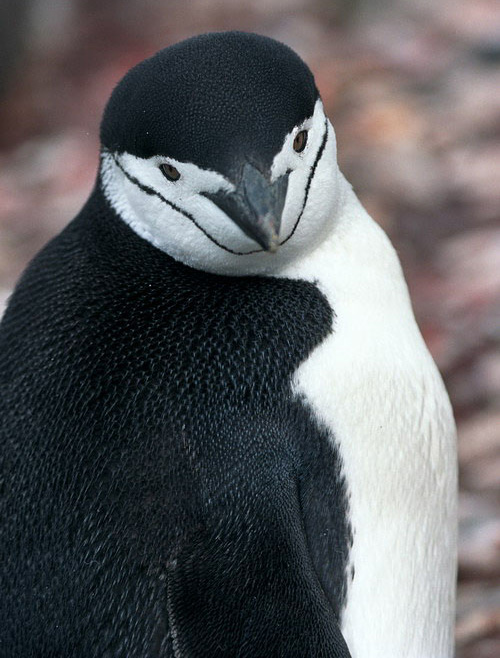
Description
Chinstrap penguins have an average body length of 72 centimetres (28 in) and a weight of 3–5 kilograms (6.6–11.0 lb), however their weight can drop as low as 3 kilograms (6.6 lb) depending on the breeding cycle. Males are both larger and heavier than females.[2]The adult chinstraps' flippers are black with a white edge; the inner sides of the flippers are white. The face is white extending behind the eyes, which are reddish brown; the chin and throat are white as well, while the short bill is black. The strong legs and the webbed feet are pink. Its short stumpy legs give it a distinct waddle when it walks. The chinstrap penguin's black-and-white plumage helps camouflage it in the water from predators such as seals. When seen from above, the bird's black back blends into the dark water below, while the bird's underside blends into the sunshine above when seen from below.[3]
Distribution and habitat

Chinstrap penguins have a circumpolar distribution. They breed in Antarctica, Argentina, Bouvet Island, Chile, the Falkland Islands, the French Southern Territories, and South Georgia and the South Sandwich Islands. Vagrant individuals have been found in New Zealand, the islands of Saint Helena and Tristan da Cunha, and South Africa. Global population is estimated at least 8 million.[1]
Ecology and behaviour

The diet of the chinstrap penguin consists of krill, shrimp, fish, and squid which they swim up to 80 km (50 mi) offshore each day to obtain. The chinstrap penguin is able to withstand swimming in freezing waters due to its tightly packed feathers, which provide a waterproof coat. Thick blubber deposits provide insulation, as well, and blood vessels in the flippers and legs have evolved intricate structures to preserve heat.[3]
On land they build circular nests from stones, and lay two eggs, which are incubated by both the male and the female for shifts of 6 days. The chicks hatch after about 37 days, and have fluffy gray backs and white fronts. The chicks stay in the nest for 20–30 days before they go to join a crèche. At around 50–60 days old, they moult, gaining their adult feathers and go to sea.[4]
The predator of adult chinstraps is the leopard seal. Eggs and chicks can fall prey to birds, such as the sheathbill and the brown skua.[4]
No comments:
Post a Comment
Note: Only a member of this blog may post a comment.